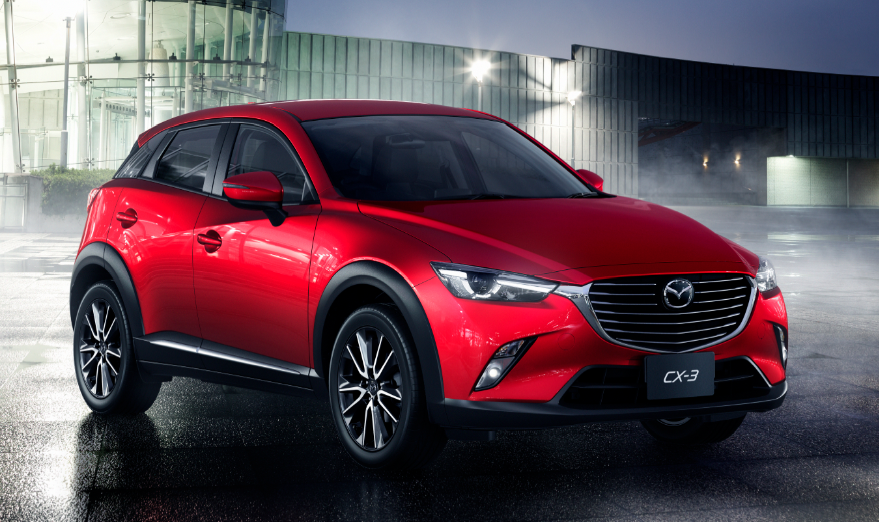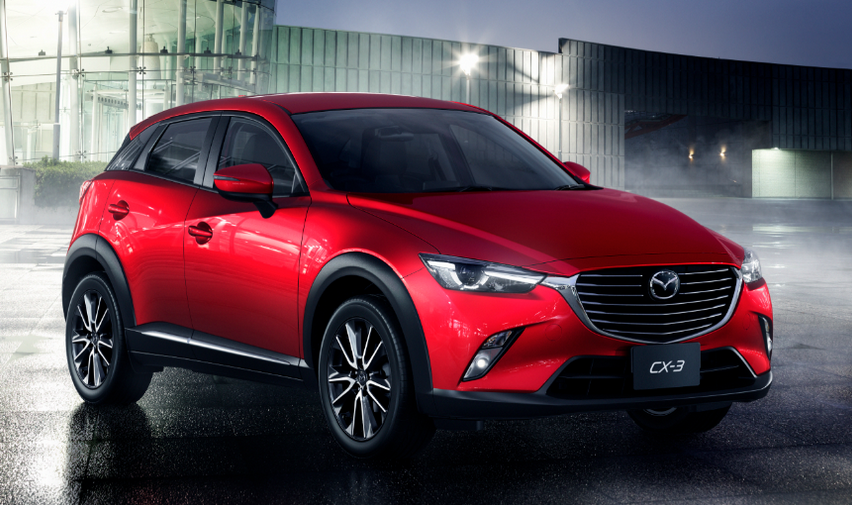
The “Subcompact SUV” class initiated by the Mini Countryman, Mitsubishi Outlander Sport, and Nissan Juke in 2011 (there were so few members that it wasn’t even considered a separate class then) and was joined in 2013 by the Buick Encore, exploded recently as five new entries were added just this year: the Chevrolet Trax, Fiat 500X, Honda HR-V, Jeep Renegade, and … last but not least … the Mazda CX-3. That makes nine in total, easily enough to qualify as its own segment.
In general, these vehicles are about 10 inches shorter and a couple thousand dollars cheaper than their respective “Compact SUV” running mates. As such, they’re favored by young and old alike for their easy maneuverability, good fuel economy, and comparatively low prices. And with at least some of them, they’re also the least-expensive way to get all-wheel drive and modern high-tech safety features that haven’t yet made their way down to lower-priced cars.
Test Drive: 2015 Mazda 3i Touring
In all those regards, the Mazda CX-3 is a strong contender. But like any other vehicle, it has to make some trade-offs; you can’t have both huge amounts of power and great fuel economy, for example, as the two just don’t go together.
Although we’re sometimes inclined to forget, “SUV” stands for “Sport-Utility Vehicle.” (Though many of the smaller ones are now being called “Crossovers” or “Crossover Utility Vehicles.”) And often leaning toward one side of the separating hyphen means sacrificing something from the other side.
In the Subcompact SUV class, the CX-3 joins the Mini Countryman, Mitsubishi Outlander Sport, and Nissan Juke on the “Sport” side of the divide. Others, such as the Chevrolet Trax and Jeep Renegade, favor the Utility side. Buick’s Encore takes an unusual luxury stance, the Honda HR-V aims for middle ground, and the Fiat 500X stands as somewhat of a fashion statement.
And the CX-3 looks the sporting part. It has an exceptionally long hood with short overhangs along with swooping side sculpturing that would do an exotic proud. And the top Grand Touring model rolls on 18-inch wheels (vs. 16s on other models), the biggest offered in the class. But the long hood, especially, takes its toll on overall space, as it effectively pushes the front of the cabin back.
Although plenty of adult headroom and legroom can be summoned up front (and there’s even good knee clearance to the center console), maxing out the seat travel gobbles up rear legroom to the point that small adults and even most kids won’t fit. However, if front-seaters are 6’ or less, an average-size adult will find enough – though hardly ample – room behind.
Cargo room also suffers a bit. The hatch opening isn’t very large and the area just inside isn’t very wide, though there’s an impressive amount of storage space under the floor. Yet with the rear seat backs up, there’s just 12.4 cubic feet of space behind them; folding the seat backs – which lay flat and level with the cargo floor – ups that to 44.5. By comparison, the figures for the competing Chevrolet Trax and Fiat 500X are about 18.5 and 49 cubic feet, and those for the Honda HR-V (the roomiest in the class) are about 24 and 58 cubic feet.
Test Drive: 2015 Mazda CX-9 Grand Touring
But that’s about all there is to complain about.
Up top we mentioned the necessary trade-off between horsepower and fuel economy, but the CX-3 offers a combination of the two that strikes an impressively good balance. Its 2.0-liter engine – bigger than most in the class – puts out only 146 horsepower, but it still feels reasonably strong in a vehicle that’s among the lightest in the segment. In combination with the standard 6-speed automatic, it provides a good full-throttle jump off the line, and the transmission kicks down quickly for more passing power. And in terms of fuel economy, CX-3 is among the best in class with EPA ratings of 29 City/35 Highway with FWD, 27/32 with AWD.
We tested both a mid-line Touring with 16-inch wheels and a top-line Grand Touring with 18s. (There were no base Sport models at the preview). In many cases, the lower-profile tires used on larger-diameter wheels inflict a penalty on ride quality due to their shorter sidewalls (which are less able to absorb small bumps), but we didn’t notice a lot of difference in this case. It’s important to note, however, that the preview was held in Southern California, where frost heaves and potholes are virtually unknown qualities. (Not so at our Chicagoland headquarters, where we’ll hopefully get to test other CX-3s soon – and record actual fuel economy.)
One thing California does have is lots of curvy roads, and those made up a sizeable portion of the driving route. Both CX-3s were AWD versions and both handled these with confident, balanced aplomb, with the Grand Touring perhaps feeling a bit more responsive to steering inputs. (Our impressions of handling might have been even better had we not spent the previous day behind the wheel of the new Miata – a sports car in the true sense of the term – which likely jaded our view a bit.)
CX3’s interior furnishing and layout are impressive as well. While the Sport model’s dark, monochromatic color scheme seemed a bit drab in the photos we were shown, the Touring brightens things up a bit with maroon-colored armrests and some nicer trim. Grand Touring goes even further with ritzy three-toning that includes lots of contrasting white, the overall effect being both classy and “techy.” The dashtop isn’t padded but many normal “touch points” are, including a swatch across the dash face along with the door sides (but not the tops) and both the door and center armrests.
Nearly all Mazdas now use a similar infotainment-system layout that features a touchscreen protruding from the top of the dash along with console-mounted control knobs. The screen may look odd to some – as though it was added after the fact (Mercedes is doing the same thing, by the way) – but it serves to put its information closer to the driver’s line of sight. Some people may not like the console-mounted control knobs, either, but many functions can be duplicated on the touchscreen and also via steering-wheel controls. Nevertheless, some adjustments require more steps than would be optimal, but that can be said for many such systems today. By contrast, the climate system is adjusted with three rotary knobs, a classic and supremely easy-to-use layout.
Visibility is quite good all around thanks to modestly thick roof pillars, though the view straight back and to the rear corners is restricted somewhat by a rather high beltline. Helping is a standard rearview camera that shows a fairly wide (though not quite 180-degree) view.
When it goes on sale in early August, front-wheel-drive versions of the CX-3 will start at $20,840 (including destination) for the Sport, running to just under $26,000 for the Grand Touring. On all models, AWD (which Mazda calls “Predictive iACTIV all-wheel drive”) is a very reasonable $1250 option.
The base Sport comes impressively well equipped with air conditioning, automatic transmission, power mirrors/windows/remote locks, cruise control, height-adjustable driver seat, CD player (not all vehicles have one anymore), and MAZDA CONNECT infotainment system with 7-inch touchscreen, voice command, Bluetooth, audio text messaging, and internet radio apps. Optional is a $400 dealer-installed navigation system. (It’s really just a programmed SD card; the hardware is already there.)
Moving up to the $22,840 FWD Touring brings 16-inch alloy wheels (in place of steel wheels with hubcaps), heated mirrors, heated front seats, leatherette and cloth upholstery, keyless access and starting, blind-spot monitor, and rear cross traffic alert. Options include a moonroof, satellite radio, a Bose audio system, and the aforementioned nav system.
Test Drive: 2016 Mazda 6i Grand Touring
Grand Touring offers a lot of items – either standard or optional – that are rare in the class. Standards include 18-inch alloy wheels, moonroof, leather upholstery, satellite radio, navigation system, automatic climate control, Head-up instrument display (Mazda calls it “Active driving display,” which crossed us up for a moment), and adaptive headlights (they pivot with the front wheels in turns). Optional is Mazda’s iACTIVSENSE package, which includes adaptive cruise control (maintains a set following distance), forward collision warning and mitigation, lane-departure warning, automatic high-beam control, and rain-sensing wipers.
Also available are numerous port- or dealer-installed options, most of which are available on any trim level. These include an auto-dimming inside rearview mirror with compass and Homelink, key-fob remote engine start, smartphone-controlled remote engine start, rear obstacle detection, and numerous roof racks.
Particularly if your interests in subcompact sport-utilities favor the “sport” side of the segment, Mazda’s new CX-3 strikes us as a credible contender with great fuel economy, lots of available features, and a strong value equation. It may be the last of the newbies to arrive, but it seems it was well worth the wait.
